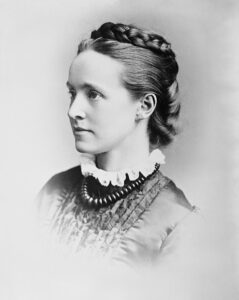
Portrait of Millicent Fawcett (1847–1929), courtesy Library of Congress Prints and Photographs Division.
Full Name: Millicent Fawcett
Birth Date: 11 June 1847
Death Date: 5 August 1929
Location: Parliament Square, London/2 Gower Street, Bloomsbury, London WC1E 6DP, UK
Monument Type: Event
Millicent was 72 years old when all the members of the British Parliament gathered in 1919 at the dawn of the new year to watch her appointment to Grand Dame of the British Empire, but her story and its origins began long before that and well into her girlhood. Born June 11, 1847, Millicent was born into a family of established upper-middle-class British citizens in the town of Alderberg in Suffolk, England. Her father, Newson Garrett, had established a successful business by the time of her birth, and her mother Louisa Garrett attended to the children as a stay-at-home mother.
The youngest in the family, Millicent took on the pet name “Millie” from her 6 older siblings and friends of the family. One such friend was suffragette Emily Davies, a close friend of Millie’s politically-liberal and socially active father. Still a young child, Davies would come over to the house to converse with Millie’s parents and older sisters, but later texts published on the family’s history reveal that she had a special interest in the promising young girl. As revealed in Millie’s sister’s biography, Davies supposedly told the young Millicent that the right to vote may not come in the older women’s lifetimes, but “you are younger than we are, Millie, so you must attend to that.” This supposedly sparked a fierce drive for political change in the child, which grew even stronger as she was whisked away to boarding school in London at age 12.
At boarding school, Millie and her friends collected signatures to petition parliament to enfranchise women, and in their free time attended lectures by progressive politicians in the city. These lectures proved to sprout fruitful connections, particularly in the case of Millicent’s meeting with Parliament member Henry Fawcett. He shared many views with liberal Millie, and at age twenty, the two married. He encouraged her to join the London Suffrage Committee that same year, organizing protests and petitions for the group. At a young age, she began to make an incredible impact on the community around her.
At 22, the National Union of Women’s Suffrage (NUWS) appointed her their president—the organization’s membership list rose to 50,000 individuals by 1905. She took this position very seriously and used her influence to educate other women on politics, something essential at a time when women were just emerging as recognized figures in the public sphere. Millie published Political Economy for Beginners, a guide to learning about Europe’s political structure intended for both male and female audiences. The book reached women internationally, with translations appearing across Europe, signaling a new era of education for Europeans of all sexes.
In 1917, the British government granted the first woman the right to vote, and at this time Millicent stepped down from her position as the president of NUWS. Millie made waves in British society, and throughout the process was granted honorary degrees from Universities along with the aforementioned Damehood. At the age of 82, with an entire life of political and social activism behind her, she died at her home in London. Her body was never buried, and her ashes remain stored at an undisclosed location.
Sources
